The Amazon Rainforest is perhaps the most well-known rainforest in the world, not only for its rich biodiversity and unparalleled beauty but because it is the largest rainforest on Earth. The Amazon covers an area larger than the Congo Basin and Indonesia combined. It is the world’s richest and most diverse biological reserve, housing millions of species of plants, birds, insects, and other forms of life, many of which have yet to be discovered by science.
When we talk about rainforests, it’s impossible to miss the snakes lurking there. Sheltering both land and marine fauna, snakes are indeed basking under the Amazon’s flourishing ecosystem. But among the large group of snakes in the Amazon, which of them is the largest? Below, we will discover the largest snake found in the Amazon, other snake species that lurk there, and other fascinating facts.
What is the Amazon Rainforest?
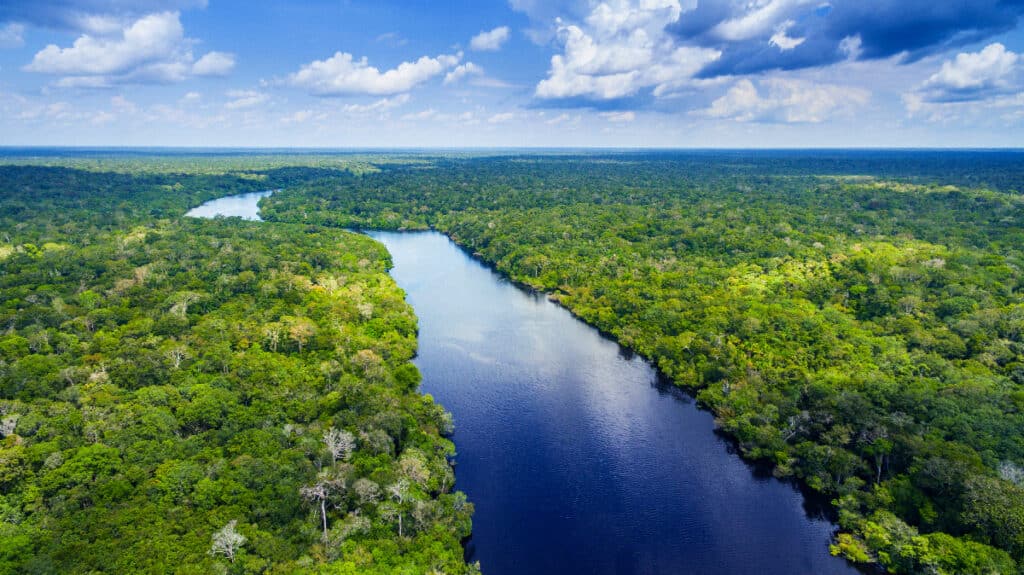
The Amazon Rainforest represents half of the world’s remaining rainforests.
©worldclassphoto/Shutterstock.com
The Amazon covers an area of over 2,100,000 square miles (5,500,000 square km) in northern South America, occupying the drainage basin of the Amazon River and its tributaries. The rainforest is the largest on the planet, encompassing over 40% of the South American continent. Parts of this massive broadleaf forest may be found in nine distinct countries: Brazil, Ecuador, Colombia, Bolivia, Peru, Venezuela, Guyana, Suriname, and French Guiana. Brazil occupies more than half of the Amazon jungle, approximately 60 percent of it.
The Amazon Rainforest, which covers most of the Amazon Basin in South America, represents half of the world’s remaining rainforests and is a place of residence for the world’s biggest and most biodiverse expanse of tropical rainforest. It is home to one out of every ten known species on the planet, 3,000 freshwater fish species, 40,000 plant species, and over 370 different types of reptiles. The Amazon is home to almost 30 million people, encompassing 350 indigenous and ethnic groups who rely on wildlife for clothing, agriculture, and medicinal products.
While the rainforests host diverse species, snakes are among the most feared when people venture into the Amazon. Rainforests are widely known to be homes of venomous snakes, and among them is the world’s largest.
What is the Largest Snake Found in the Amazon?
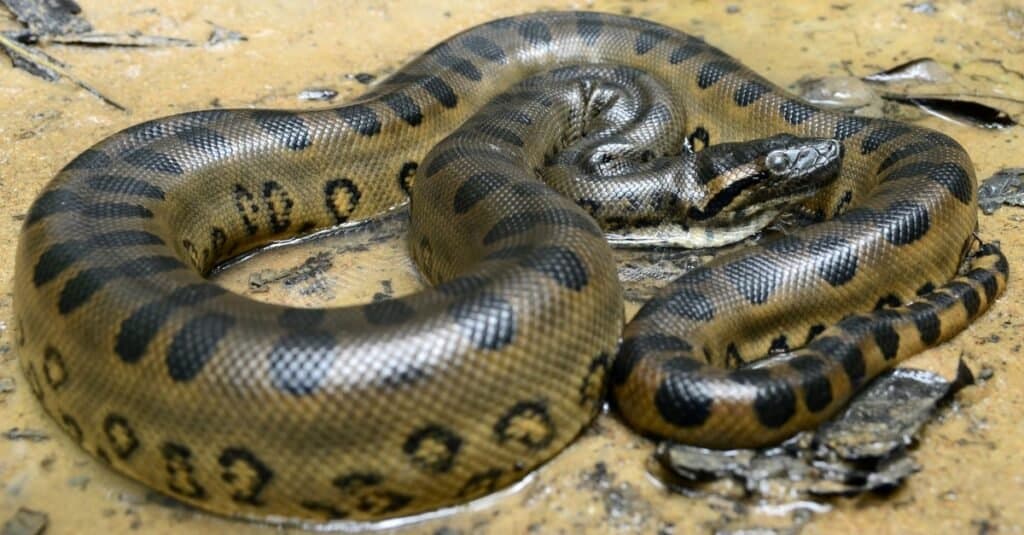
The green anaconda is the largest snake in the Amazon.
©Patrick K. Campbell/Shutterstock.com
The largest snake that lives in the Amazon Forest is the green anaconda. Not surprisingly, the South American snake is also, pound for pound, the largest snake on the planet. The reticulated python can grow slightly longer, but the anaconda’s massive girth makes it nearly twice as hefty. The name Anaconda represents a group of four species of snakes found in South America’s tropical areas. As the largest member of the anaconda family, the green anaconda (Eunectes murinus) is the most well-known of these four species.
How Big Are Green Anacondas?
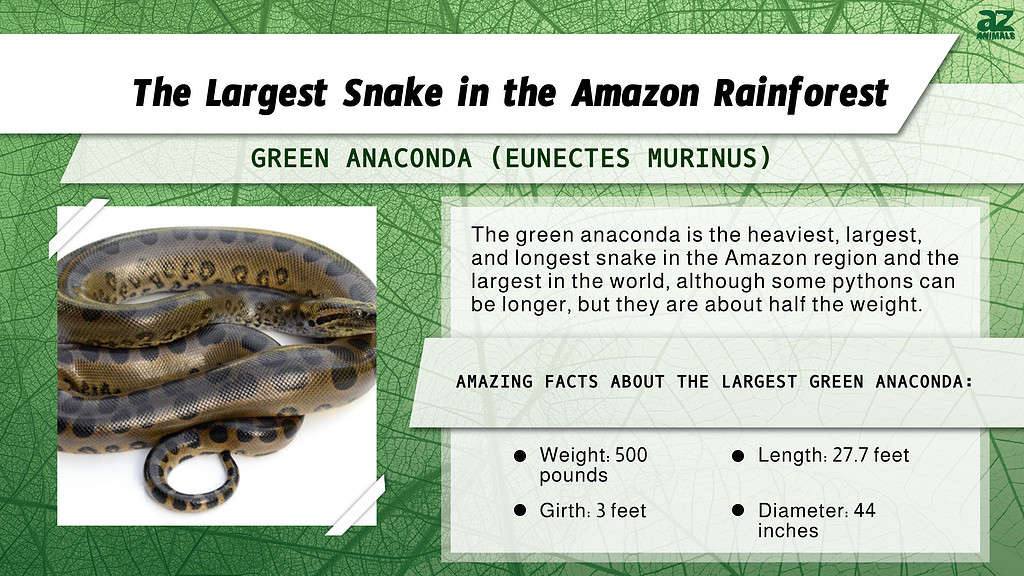
The average green anaconda can be about 20 feet long and weigh 200-300 pounds. Apart from being the largest snake, no other serpent can top the green anaconda’s heftiness. Anacondas are huge, thick-skinned snakes that can weigh up to 500 pounds. If you extended a green anaconda out to its full length, it would be about the length of a school bus! Female green anacondas are typically larger than males.
Even if you disregard the theoretical longest snake record, green anacondas are still the biggest snakes. Reticulated and Burmese pythons are both extremely lengthy snakes. However, because they are thin, they do not weigh much. The longest and heftiest anaconda ever reported weighed 500 pounds, was 27.7 feet long, had a 3-foot girth, and a diameter of 44 inches.
The green anaconda is South America’s heaviest, largest, and longest snake. The python is still the longest snake in the world, but in respect of weight and diameter, the green anaconda tops the largest snakes in South America and the Amazon rainforest, as well as the world.
Where to Find Green Anacondas in the Amazon

Green anacondas are clumsy on land, yet agile in water
©Mark_Kostich/Shutterstock.com
Green anacondas are common in Brazil’s Amazon rainforests and wetlands. After all, anacondas are water boas who spend a lot of time in the extensive network of waterways that crisscross South America. They prefer to stay in tropical jungles and appreciate being near water. This means they can be found in slow-moving waters like rivers and streams. They are bulky on land yet sneaky and sleek on water. Because their eyes and nasal passages sit on top of their heads, they may lay in wait for prey while keeping nearly submerged.
They usually lurk in tall vegetation when not in the water, allowing them to ambush prey. Furthermore, they appreciate remaining hidden from other predators looking to make a meal out of them.
Green anacondas are native to South America, although they can be found worldwide. These giant snakes have indeed made their way to the United States. They are one of the numerous invasive species that have arrived in the United States, most notably in the Florida Everglades.
Are Green Anacondas Dangerous?

Although they are not aggressive, green anacondas can be extremely dangerous to humans given their immense size and strength
©iStock.com/Schumaher
While green anacondas, or any anaconda species, do not belong to the venomous group of snakes, they are still very dangerous. They are constrictors, which means they subdue their prey by constricting or wrapping their long and hefty bodies around their prey and squeezing it before swallowing it whole.
As green anacondas grow almost five times human length and weigh hundreds of pounds, they can be extremely dangerous. Although reports of attacks on humans are rare, they can take down large animals such as deer and, on some occasions, jaguars. Still, with such a gigantic slithering body, you might want to step aside, especially if you are wandering around its quarters. Thankfully, green anacondas are not extremely aggressive in the wild.
Are Green Anacondas Aggressive?
Unlike their smaller cousins, yellow anacondas, green anacondas are not aggressive. As a matter of fact, scientists have been known to approach them and simply scoop them up for the purpose of studying them. What’s more, attacks on humans are pretty rare. However, in light of their impressive bulk, and length, not to mention their terrifying ability to subdue powerful prey such as caimans, approaching them all alone and without taking the necessary precautions is highly inadvisable.
How Long Do Green Anacondas Live?
In general, green anacondas aren’t particularly long-lived and often have a lifespan of about 10 years. However, that figure can actually double in captivity and green anacondas have been known to live for up to 20 years when placed in facilities.
What Do Green Anacondas Eat?

Caimans are just one of the many creatures which feature on green anacondas’ menus.
©Ondrej Prosicky/Shutterstock.com
Anacondas are carnivorous animals that consume deer, caimans, birds, jaguars, and other animals. Juveniles prefer to consume fish, birds, and small mammals. Because green anacondas live in marshes and swamps, they hunt aquatic species such as capybara, turtles, frogs, and fish. Anacondas move poorly and slowly on land, but they are quick and skilled hunters in the water.
Green anacondas submerge the majority of their bodies before striking their opponents. They can stay entirely submerged for 10 minutes, with only their eyes visible. When they come to something edible, they will leap from the water, seize the victim, wrap it up, and kill it. Females will occasionally cannibalize males, particularly during breeding seasons. Anacondas may seek and kill huge prey such as deer, which implies they don’t need to eat as frequently after a kill. They have a relatively slow metabolism, allowing them to live for several months without eating.
What Other Snakes Are Found in the Amazon Rainforest?
The Amazonian wildlife is diverse and exciting, with huge snakes among its inhabitants. While they may appear frightening, most of them are harmless to humans—as long as you don’t puncture one of them with your finger, of course! Apart from the world’s largest snake, other native snake species in the rainforest help balance the habitat’s thriving ecosystem. Here are some of the other snakes that are found in the Amazon rainforest:
Rainbow boa

Rainbow boas are large, voracious constrictors which have shimmering scales that reflect brilliant colors
©Kassia Marie Ott/Shutterstock.com
The rainbow boa, commonly referred to as the slender boa, is an elegant mid-sized Amazon Rainforest snake. Rainbow boas are considered small compared to other boa species, reaching a maximum length of six feet. They have big bodies with scales that reflect light in brilliant colors, just like a rainbow. This snake’s appetite is insatiable. They spend most of their time in the water and devour everything from rodents to birds, squeezing rather than envenomating their victim.
Yellow Anaconda

Yellow anacondas aren’t great pets and can be aggressive.
©cellistka/Shutterstock.com
The 9-foot-long yellow anaconda is one of the largest snakes in the rainforest and one of the world’s largest snakes, trailing only its close sibling, the green anaconda. This species primarily preys on wetland and riparian creatures, including turtles, smaller fishes, bird eggs and birds, small mammals, and other snakes. Since yellow anacondas are found in South America, it is known to lurk in the shallows of the Amazon.
South American Rattlesnake
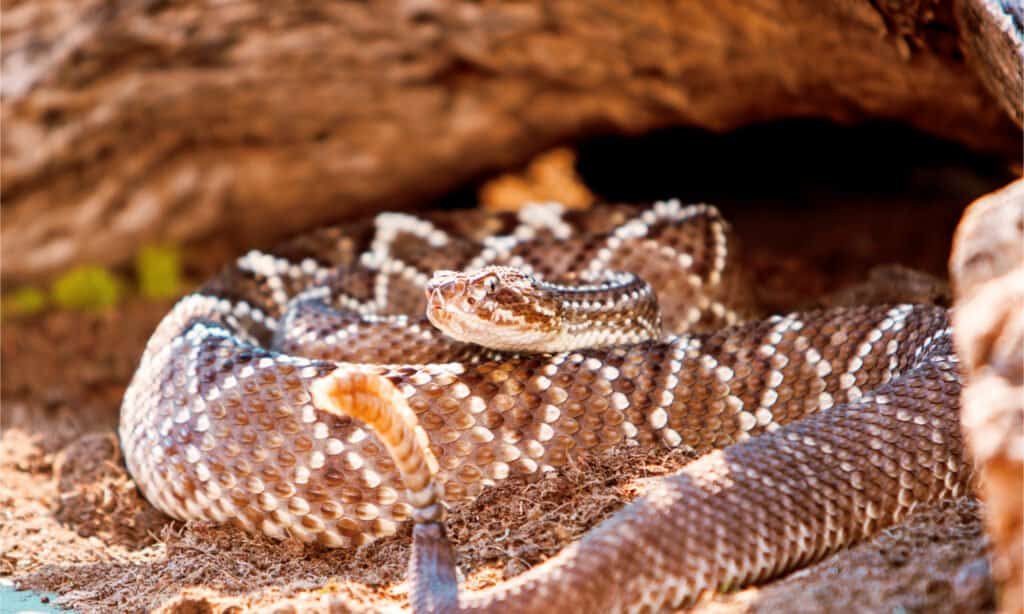
South American rattlesnakes can grow up to 6 feet long.
©GoodFocused/Shutterstock.com
The Amazon is home to several snake species, the most hazardous being the South American Rattlesnake. These rattlesnakes live in the Amazon’s savannah zones and are, in fact, well known in the area for their more potent venom compared to other rattlesnakes. These Amazon snakes prefer to live in dry open areas and grasslands. Their venomous snake bites are extremely dangerous to humans and can rapidly destroy the neurological system.
Amazon Tree Boa
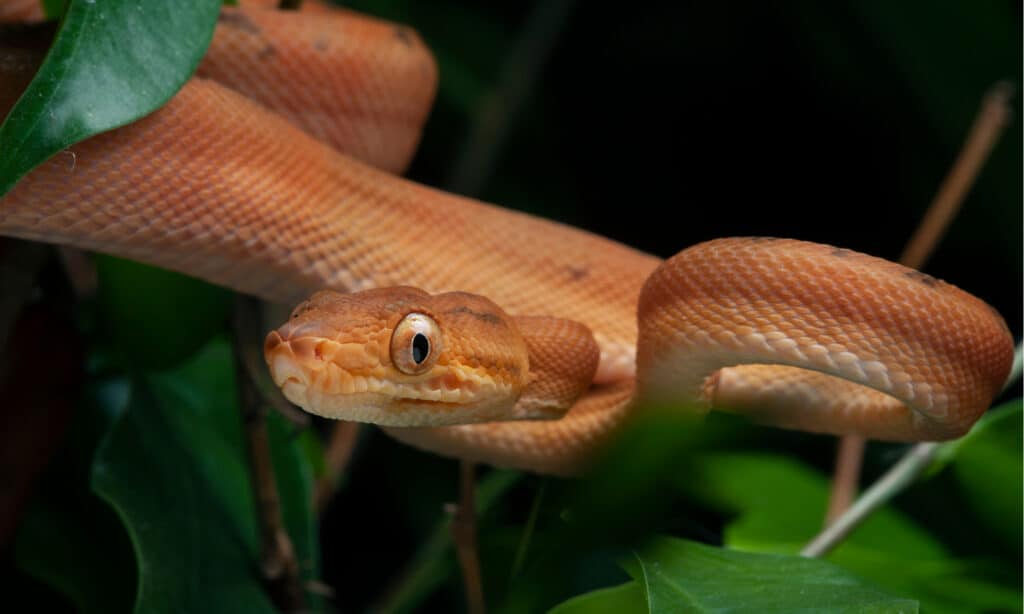
Amazon tree boas eat rodents and bats.
©Amazon Tree Boa/Shutterstock.com
The Amazon tree boa is another non-venomous snake found in the Amazon Rainforest, with a stunning array of colors and patterns. It feeds on small lizards when it is young, but it starts eating rodents, bats, and young birds as it becomes larger.
Green Vine Snake
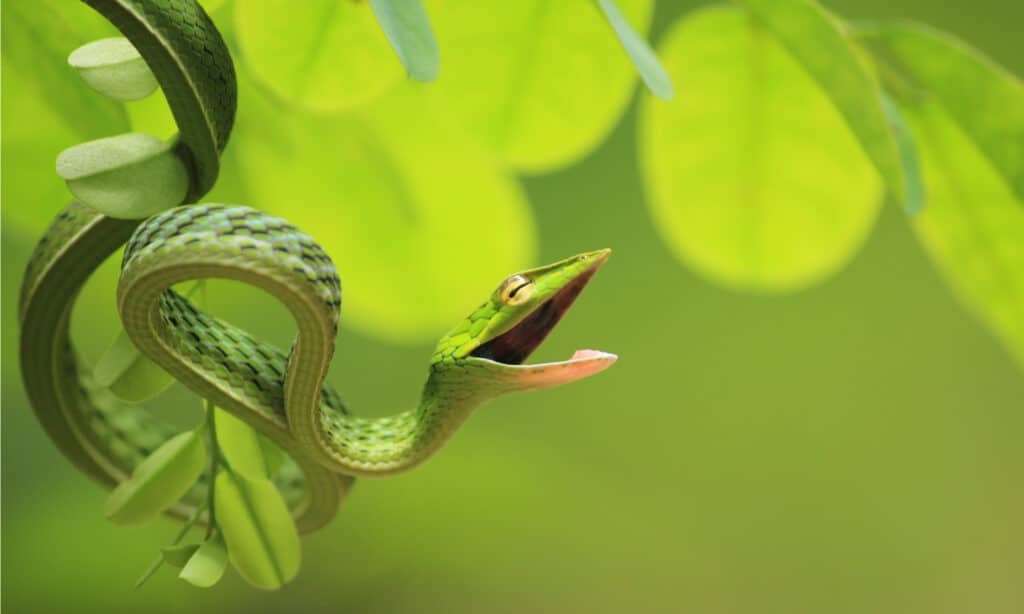
Found in Central and South America, green vine snakes have slim bodies and can grow to be six feet long.
©Nikhil patil 0321/Shutterstock.com
Green vine snakes can be found in both Central and South America. They have slim bodies and can grow to be six feet long. They have glowing green skin, orange eyes, and a pointy snout. Green vine snakes mostly prey on small lizards, birds, and frogs.
The photo featured at the top of this post is © Curioso.Photography/Shutterstock.com
Thank you for reading! Have some feedback for us? Contact the AZ Animals editorial team.






